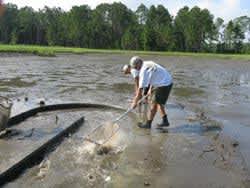Florida Biologists Condition Hatchery Bass to Survive Life in the Wild

Anglers across North America agree: largemouth bass are one of the most exciting sport fish around. Their spunky, combative behavior when hooked makes them popular targets for seasoned fishers. Largemouth bass are especially prevalent in the southeastern U.S., and Florida is noted as one of the top states for fishing for this species. Stocking lakes and rivers is a common method used by fisheries managers attempting to enhance or restore largemouth populations, but many stocking projects in Florida and across the country have resulted in low survival of hatchery-raised fish. In 2008, FWRI Freshwater Fisheries Research biologists began a project to investigate these survival rates and improve them by better preparing the fish for life in the wild.
To set a baseline, biologists stocked traditionally raised hatchery bass into Lake Carlton in Lake County. There, they tracked the hatchery fish and select wild bass using radio transmitters to compare behavior and survival. The differences were stark. Researchers found that hatchery bass tended to leave cover more often than wild bass, exposing them to predators and leading to higher death rates. Biologists also collected both hatchery-raised and wild bass from the lake months later and noted that wild bass grew at a significantly higher rate.
These findings led scientists to test a new method for raising hatchery fish at the FWC’s Florida Bass Conservation Center in Sumter County, with the goal of improving their survival. Rather than raising all of the largemouth bass exclusively indoors, researchers moved half of the fish outside ten days before they were to be stocked. The outdoor fish were conditioned to seek out live prey in a natural environment in earthen ponds and exposed to predators along with natural days and nights. The indoor fish were raised in a traditional manner on artificial feed in concrete tanks. Researchers then combined the conditioned fish and the naïve indoor fish into one-acre hatchery ponds meant to simulate natural water bodies and then measured survival one month after stocking.
So far, project scientists have found that conditioning produces positive effects. Pond studies have shown higher survival rates for fish conditioned to predators and live prey. The conditioned fish also tend to outgrow their naïve counterparts. Moving forward, researchers will evaluate the long-term survival of these hatchery-raised largemouth bass in the wild by stocking both the conditioned and naïve fish into natural lakes. If conditioning is found to improve stocking success, the added step could become a necessary part of the stock enhancement process for a variety of species and locations; www.myfwc.com.

